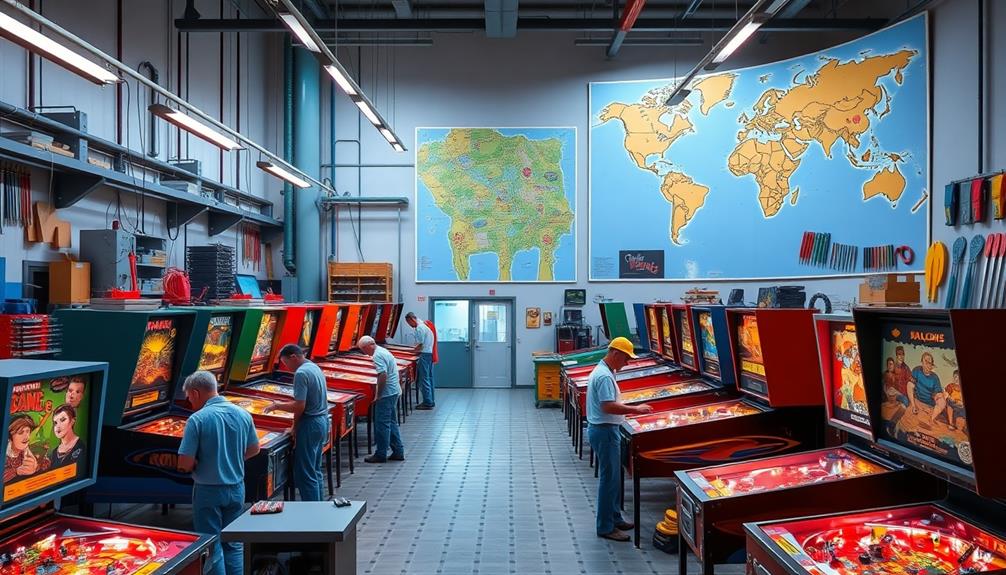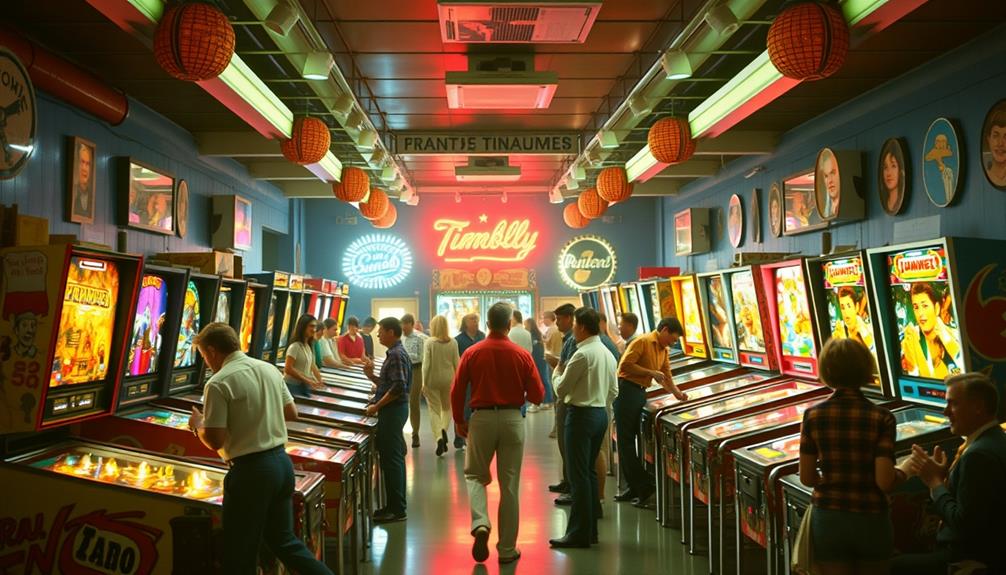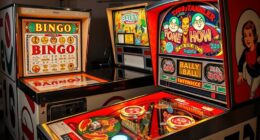Stern Pinball is situated in Elk Grove Village, Illinois, conveniently close to Chicago O’Hare International Airport. Encompassing 110,000 square feet, the facility boosts their design, engineering, and production capabilities. This spot serves as a key center for innovation and community involvement, nurturing connections with enthusiasts and collectors alike. Furthermore, it offers easy access with a variety of transportation choices. If you’re thinking about paying a visit, you’ll discover nearby attractions and amenities to indulge in while you’re in the vicinity. Stay tuned to learn more about their intriguing history and what to anticipate during your visit.
Key Takeaways
- Stern Pinball, Inc. is located in Elk Grove Village, Illinois, near Chicago O'Hare International Airport.
- The facility spans 110,000 square feet, enhancing design, engineering, and production capacity.
- It serves as a central hub for innovation and growth in the pinball industry.
- The location is accessible via major transportation routes, public transit, and ride-sharing services.
- Nearby attractions include Busse Woods, Woodfield Mall, and local parks for visitor enjoyment.
Location Overview
Stern Pinball, Inc. is conveniently located in Elk Grove Village, Illinois, just a stone's throw from Chicago O'Hare International Airport. This strategic position allows easy access for both domestic and international operations, making logistics a breeze.
The facility spans 110,000 square feet, effectively doubling its design, engineering, and production capacity. By relocating to Elk Grove Village, Stern Pinball supports its expansion initiatives, which are fueled by the surging international collector community and competitive player leagues. This growth mirrors the increasing demand for high-quality entertainment options, similar to the way top projectors for gaming enthusiasts cater to a vibrant gaming market.
Choosing Elk Grove Village wasn't just about space; it's also about historical significance. This area has deep roots in the pinball industry, enhancing Stern Pinball's brand visibility and presence within the community.
You'll find that the combination of location and facility size plays a vital role in the company's mission to deliver high-quality pinball machines. This location provides a central hub for innovation and growth while fostering relationships with fans and collectors alike.
Whether you're a player, a collector, or just a fan of pinball, knowing that Stern Pinball operates out of Elk Grove Village adds an extra layer of excitement to your experience.
Company History

Stern Pinball's story begins with the formation of Stern Electronics, which set the stage for its evolution into a leading manufacturer of pinball machines.
The company has a rich history that reflects the broader trends in the pinball industry, including the shift from mechanical to electronic scoring systems and the introduction of innovative gameplay features. This evolution in technology has kept the company at the forefront of pinball innovation, continually adapting its machines to meet the preferences of players. One such innovation is the patented pinball bumper mechanism, which revolutionized gameplay by creating more unpredictable and exciting ball movement. As the demand for more interactive and immersive gaming experiences continues to grow, the company remains dedicated to pushing the boundaries of pinball technology.
You'll see how the company adapted over the years, responding to industry changes and growing its presence.
Understanding this history helps you appreciate the legacy and innovation that define Stern Pinball today, particularly its role in the resurgence of pinball popularity in contemporary culture the history of pinball machines.
Formation of Stern Electronics
In 1977, a significant shift occurred in the pinball industry with the establishment of Stern Electronics, Inc. Following the acquisition of Chicago Coin's assets during its bankruptcy, Stern emerged as a new player in the amusement world. You'd find their early games, like "Stampede" and "Rawhide," were rebranded from the previous inventory, marking the beginning of an exciting era.
| Year | Key Events | Impact |
|---|---|---|
| 1977 | Establishment of Stern | New competitor in pinball |
| 1978 | change to solid-state | Modernized gameplay technology |
| 1979 | Acquired jukebox assets | Diversified product offerings |
| 1985 | Exit from the market | Economic challenges faced |
Stern experienced sales growth by late 1977, capitalizing on the change to solid-state electronics. However, despite these early successes, the company faced significant economic challenges in the amusement industry. By 1985, Stern Electronics exited the market, leaving a lasting impact on the pinball landscape. Their innovative approaches and products set the stage for future developments in pinball gaming.
Evolution to Stern Pinball
The evolution of pinball took an important turn with the formation of Stern Pinball, Inc. in October 1999, when it acquired Sega's pinball division, which was previously part of Data East. This acquisition marked a pivotal moment in the pinball industry, establishing Stern as one of the largest manufacturers of pinball machines.
With a commitment to producing high-quality machines, Stern has been a driving force in the resurgence of pinball, appealing to both casual and serious gamers alike, as seen in their best arcade machines for home game rooms. Headquartered in Elk Grove Village, Illinois, Stern operates from a spacious 110,000 square foot facility, enhancing its production capacity.
The company has become synonymous with innovation and quality, producing beloved titles that have captivated players worldwide. Some of these standout games include:
- "WWE WrestleMania"
- "The Walking Dead"
- "Star Trek"
- "Batman"
- "Guardians of the Galaxy"
Stern Pinball has played a vital role in revitalizing interest in pinball, attracting a diverse demographic of players. Their commitment to collaborating with renowned designers like Brian Eddy and engaging partnerships with competitive players has greatly boosted their brand visibility and offerings.
As a result, Stern remains a driving force in the pinball industry, continually pushing boundaries and celebrating the joy of pinball.
Facility Details

Located in Elk Grove Village, Illinois, near Chicago O'Hare International Airport, Stern Pinball, Inc. operates out of a state-of-the-art facility that spans 110,000 square feet.
This impressive space has doubled its design, engineering, and production capacity, allowing Stern to meet the increasing demands of the global pinball industry. The relocation to this larger facility was driven by a surge in interest from collectors and competitive leagues, reflecting the vibrant growth of pinball.
The resurgence of pinball has been marked by the release of best rated pinball machines of 2024, showcasing modern innovations and classic designs that excite enthusiasts.
Consolidating operations in this metropolitan Chicago location not only enhances operational efficiencies and production workflows but also places Stern in a historically significant area for the pinball industry.
This proximity boosts brand visibility and connects the company to its roots.
For those interested in the pinball world, Stern Pinball offers facility tours, providing a behind-the-scenes look at how your favorite games come to life.
You'll get a firsthand experience of the craftsmanship and innovation that goes into each machine.
Whether you're a die-hard fan or new to the hobby, visiting the facility can deepen your appreciation for this beloved pastime in the State of Illinois.
Accessibility and Directions

Getting to Stern Pinball is easy, thanks to its prime location near Chicago O'Hare International Airport.
You'll find plenty of transportation options, whether you're driving or using public transit.
Many visitors enjoy nearby attractions, including top hotels with water parks that provide family-friendly experiences.
Plus, you'll spot nearby landmarks that make traversing the area straightforward.
Transportation Options Available
Offering convenient access for travelers, Stern Pinball, Inc. is situated in Elk Grove Village, Illinois, close to Chicago O'Hare International Airport. This prime location means you have various transportation options to make your visit hassle-free.
Additionally, planning your visit with a well-structured budget can enhance your overall experience.
Here are some ways you can reach Stern Pinball:
- Public Transit: Utilize nearby public transit options for easy access without needing a personal vehicle.
- Driving: If you prefer driving, ample parking facilities are available at the headquarters.
- Ride-Sharing Services: Consider using ride-sharing apps for a quick and convenient drop-off.
- Biking: For the eco-conscious, biking to the location is a viable option, with bike racks available.
- Walking: If you're staying close by, walking is a pleasant way to enjoy the area.
The facility is designed with ADA compliance to guarantee accessibility for all visitors, including those with disabilities.
Directions to the location can be easily found on their website, which also includes maps for better navigation. With these options, reaching Stern Pinball is straightforward and accessible for everyone.
Nearby Landmarks Identified
Just a short drive from Stern Pinball, you'll find several notable landmarks that enhance your visit. The Elk Grove Village area is rich in history and accessibility, making it easy to explore additional attractions while you're in town.
Here's a quick overview of nearby landmarks that you might want to check out:
| Landmark | Description |
|---|---|
| The Union | A historic site, great for photos and learning about local heritage. |
| Factory Tours | Experience the pinball production process firsthand with guided tours. |
| Major Highways | Convenient access to and from Stern Pinball, making your travels seamless. |
With major highways nearby and public transit options available, getting around is a breeze. Whether you're interested in the history of pinball or just want to enjoy the local culture, these landmarks add value to your experience. So, plan your visit to include stops at these sites, and make the most of your time in Elk Grove Village!
Nearby Attractions

Visitors to Stern Pinball will find a variety of nearby attractions that enhance their experience. Located in Elk Grove Village, Illinois, you're just a short drive from exciting spots that complement your visit to see the latest pinball machines.
Whether you're looking for outdoor adventures or shopping, there's plenty to explore, and you can discover some great dining options nearby that feature live music to elevate your evening.
Here are some nearby attractions you won't want to miss:
- Busse Woods: A beautiful forest preserve perfect for hiking and biking.
- Woodfield Mall: One of the largest shopping malls in the U.S., offering a diverse range of retail and dining options, just 10 miles away.
- Community Parks: Numerous parks in the Elk Grove Village area for family-friendly activities.
- Dining Options: A variety of restaurants nearby to satisfy your cravings after a day of fun.
- Entertainment Venues: Local spots that provide additional fun and leisure activities.
These nearby attractions make your visit to Stern Pinball even more enjoyable, ensuring you have plenty to do before or after checking out the amazing pinball machines.
Game Offerings

After enjoying the nearby attractions, you can explore the wide array of game offerings at Stern Pinball. The company provides a full line of commercial and consumer arcade-quality pinball machines, perfect for both casual gamers and competitive players.
Recent popular titles like "WWE WrestleMania," "The Walking Dead," and "Star Trek" showcase a unique blend of classic themes and modern gameplay mechanics, making them a hit among fans. This mirrors the adaptability seen in Cressida Bonas' lockdown wedding, highlighting how creativity can thrive during challenging times.
Stern Pinball has also expanded its game offerings through collaborations with renowned designers such as Pat Lawlor, Brian Eddy, and John Borg. These partnerships have led to innovative designs and enhancements, keeping the gameplay fresh and engaging.
You'll find that each machine reflects ongoing trends in game mechanics, ensuring an exciting experience every time you play. Additionally, Stern maintains a regular update schedule for its games, so you'll always have access to new features and improved gameplay experiences.
Whether you're a seasoned pro or just starting, you'll discover something that appeals to your competitive spirit and keeps you coming back for more.
Factory Tours

Experience the inner workings of Stern Pinball by taking one of their engaging factory tours. These tours provide you with a unique glimpse into the manufacturing processes behind their arcade-quality pinball games.
You'll witness firsthand the craftsmanship and innovation that goes into every machine, promoting transparency and trust in the brand. By fostering a culture of innovation and creativity, these experiences resonate with the principles of design thinking, encouraging visitors to appreciate not just the final product, but also the thoughtful processes behind it.
During your visit, you can expect to learn about:
- The step-by-step production of pinball games
- The skilled artisans behind the craftsmanship
- The economic impact of pinball manufacturing
- How these tours encourage interest in STEM education
- The community engagement efforts of Stern Pinball
Contact Information

Stern Pinball, Inc. makes it easy for you to get in touch with them for any inquiries or support. If you have questions about their popular pinball machines or need assistance, you can visit their website, where a contact form is readily available. They also offer email and phone support options, ensuring you can choose the method that works best for you.
Additionally, just as with modern toilets that enhance efficiency and performance, Stern Pinball continuously innovates to enhance the gaming experience. Their commitment to quality is reflected in their detailed product information and customer support, which you can explore through their customer engagement resources.
The company's headquarters is located in Elk Grove Village, Illinois, conveniently near Chicago O'Hare International Airport, making it accessible for visitors. With a spacious facility of 110,000 square feet, they've expanded their design, engineering, and production capabilities, enhancing their commitment to customer satisfaction.
Stern Pinball values prompt responses and encourages positive engagement with the brand. They regularly update their website, which features game listings, upcoming events, and direct links for customer inquiries.
You can also tune in for the "Stern of the Union" updates that keep you informed about the latest in their pinball world. So whether you're a long-time fan or new to the game, reaching out to Stern Pinball is straightforward and efficient.
Community Engagement

Engaging with the pinball community is a top priority for Stern Pinball, as they actively promote events and competitions that cater to players of all skill levels. This commitment hasn't only revived interest in pinball but also fostered strong community engagement.
You can connect with fellow enthusiasts and share your passion through various initiatives.
Here are some ways Stern Pinball enhances community involvement:
- Collaborates with top players and streamers, like Keith Elwin and Jack Danger
- Hosts diverse tournaments and leagues for all skill levels
- Maintains an active social media presence for updates and networking
- Encourages player feedback and reviews to foster a sense of ownership
- Highlights "Heroes in the Past" to celebrate influential figures in pinball history
Frequently Asked Questions
Where Is the Stern Pinball Factory?
You're curious about the Stern Pinball factory. It's situated in Elk Grove Village, Illinois. This location enhances production capacity and accessibility, supporting the growing demand for pinball machines among collectors and competitive players worldwide.
How Many Pinball Machines Does Stern Make a Year?
Like a pinball bouncing around, you'll find Stern Pinball produces around 2,500 to 3,000 machines each year. Their commitment to quality and innovation keeps the excitement rolling in both arcades and homes alike.
Who Owns Stern Pinball?
You'll find that Stern Pinball is owned by Gary Stern, who's been a pivotal figure in the pinball industry. His leadership has shaped the company into the largest manufacturer of arcade-quality pinball machines today.
Does Stern Still Make Pinball Machines?
You'll be glad to know Stern's still making pinball machines! They're innovating with fresh designs and themes, enchanting both new and seasoned players. Their growth shows how much fun pinball is these days!
Conclusion
In the heart of Melrose Park, Illinois, Stern Pinball beckons you to explore the world of pinball magic. As you step into their vibrant facility, you'll feel the pulse of creativity and innovation surrounding you. With the clinking of coins and the joyful laughter echoing in the air, it's like stepping into a time machine, where nostalgia meets cutting-edge design. So, grab your friends and experience the enchanting domain of pinball at Stern—where every game tells a story.









